Di Yang
LaTeXTrans: Structured LaTeX Translation with Multi-Agent Coordination
Aug 26, 2025Abstract:Despite the remarkable progress of modern machine translation (MT) systems on general-domain texts, translating structured LaTeX-formatted documents remains a significant challenge. These documents typically interleave natural language with domain-specific syntax, such as mathematical equations, tables, figures, and cross-references, all of which must be accurately preserved to maintain semantic integrity and compilability. In this paper, we introduce LaTeXTrans, a collaborative multi-agent system designed to address this challenge. LaTeXTrans ensures format preservation, structural fidelity, and terminology consistency through six specialized agents: 1) a Parser that decomposes LaTeX into translation-friendly units via placeholder substitution and syntax filtering; 2) a Translator, Validator, Summarizer, and Terminology Extractor that work collaboratively to ensure context-aware, self-correcting, and terminology-consistent translations; 3) a Generator that reconstructs the translated content into well-structured LaTeX documents. Experimental results demonstrate that LaTeXTrans can outperform mainstream MT systems in both translation accuracy and structural fidelity, offering an effective and practical solution for translating LaTeX-formatted documents.
SoccerNet 2025 Challenges Results
Aug 26, 2025Abstract:The SoccerNet 2025 Challenges mark the fifth annual edition of the SoccerNet open benchmarking effort, dedicated to advancing computer vision research in football video understanding. This year's challenges span four vision-based tasks: (1) Team Ball Action Spotting, focused on detecting ball-related actions in football broadcasts and assigning actions to teams; (2) Monocular Depth Estimation, targeting the recovery of scene geometry from single-camera broadcast clips through relative depth estimation for each pixel; (3) Multi-View Foul Recognition, requiring the analysis of multiple synchronized camera views to classify fouls and their severity; and (4) Game State Reconstruction, aimed at localizing and identifying all players from a broadcast video to reconstruct the game state on a 2D top-view of the field. Across all tasks, participants were provided with large-scale annotated datasets, unified evaluation protocols, and strong baselines as starting points. This report presents the results of each challenge, highlights the top-performing solutions, and provides insights into the progress made by the community. The SoccerNet Challenges continue to serve as a driving force for reproducible, open research at the intersection of computer vision, artificial intelligence, and sports. Detailed information about the tasks, challenges, and leaderboards can be found at https://www.soccer-net.org, with baselines and development kits available at https://github.com/SoccerNet.
LIA-X: Interpretable Latent Portrait Animator
Aug 13, 2025Abstract:We introduce LIA-X, a novel interpretable portrait animator designed to transfer facial dynamics from a driving video to a source portrait with fine-grained control. LIA-X is an autoencoder that models motion transfer as a linear navigation of motion codes in latent space. Crucially, it incorporates a novel Sparse Motion Dictionary that enables the model to disentangle facial dynamics into interpretable factors. Deviating from previous 'warp-render' approaches, the interpretability of the Sparse Motion Dictionary allows LIA-X to support a highly controllable 'edit-warp-render' strategy, enabling precise manipulation of fine-grained facial semantics in the source portrait. This helps to narrow initial differences with the driving video in terms of pose and expression. Moreover, we demonstrate the scalability of LIA-X by successfully training a large-scale model with approximately 1 billion parameters on extensive datasets. Experimental results show that our proposed method outperforms previous approaches in both self-reenactment and cross-reenactment tasks across several benchmarks. Additionally, the interpretable and controllable nature of LIA-X supports practical applications such as fine-grained, user-guided image and video editing, as well as 3D-aware portrait video manipulation.
AutoCBT: An Autonomous Multi-agent Framework for Cognitive Behavioral Therapy in Psychological Counseling
Jan 16, 2025



Abstract:Traditional in-person psychological counseling remains primarily niche, often chosen by individuals with psychological issues, while online automated counseling offers a potential solution for those hesitant to seek help due to feelings of shame. Cognitive Behavioral Therapy (CBT) is an essential and widely used approach in psychological counseling. The advent of large language models (LLMs) and agent technology enables automatic CBT diagnosis and treatment. However, current LLM-based CBT systems use agents with a fixed structure, limiting their self-optimization capabilities, or providing hollow, unhelpful suggestions due to redundant response patterns. In this work, we utilize Quora-like and YiXinLi single-round consultation models to build a general agent framework that generates high-quality responses for single-turn psychological consultation scenarios. We use a bilingual dataset to evaluate the quality of single-response consultations generated by each framework. Then, we incorporate dynamic routing and supervisory mechanisms inspired by real psychological counseling to construct a CBT-oriented autonomous multi-agent framework, demonstrating its general applicability. Experimental results indicate that AutoCBT can provide higher-quality automated psychological counseling services.
Small Language Model as Data Prospector for Large Language Model
Dec 13, 2024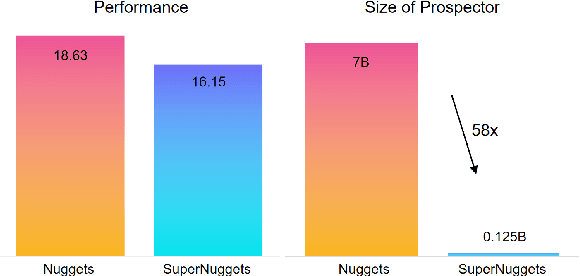
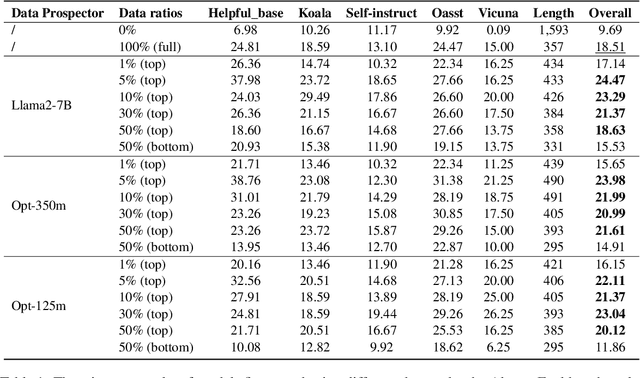
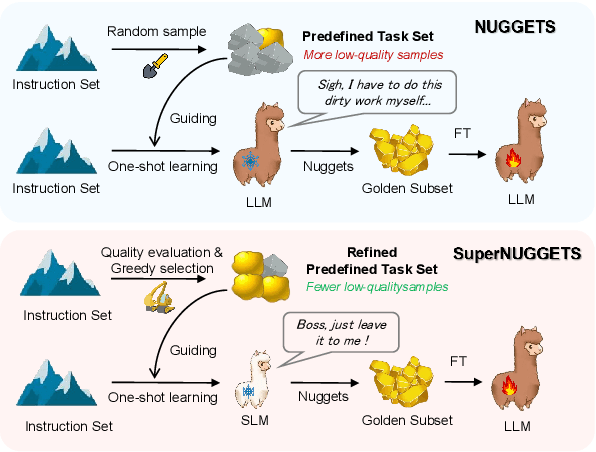

Abstract:The quality of instruction data directly affects the performance of fine-tuned Large Language Models (LLMs). Previously, \cite{li2023one} proposed \texttt{NUGGETS}, which identifies and selects high-quality quality data from a large dataset by identifying those individual instruction examples that can significantly improve the performance of different tasks after being learnt as one-shot instances. In this work, we propose \texttt{SuperNUGGETS}, an improved variant of \texttt{NUGGETS} optimised for efficiency and performance. Our \texttt{SuperNUGGETS} uses a small language model (SLM) instead of a large language model (LLM) to filter the data for outstanding one-shot instances and refines the predefined set of tests. The experimental results show that the performance of \texttt{SuperNUGGETS} only decreases by 1-2% compared to \texttt{NUGGETS}, but the efficiency can be increased by a factor of 58. Compared to the original \texttt{NUGGETS}, our \texttt{SuperNUGGETS} has a higher utility value due to the significantly lower resource consumption.
Are Visual-Language Models Effective in Action Recognition? A Comparative Study
Oct 22, 2024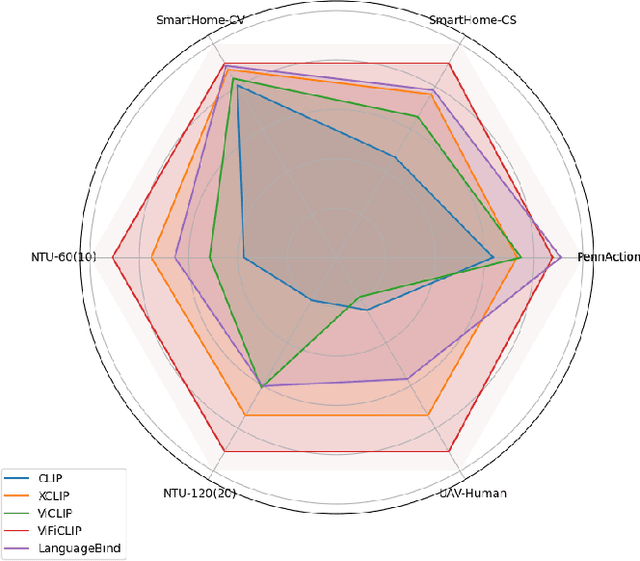


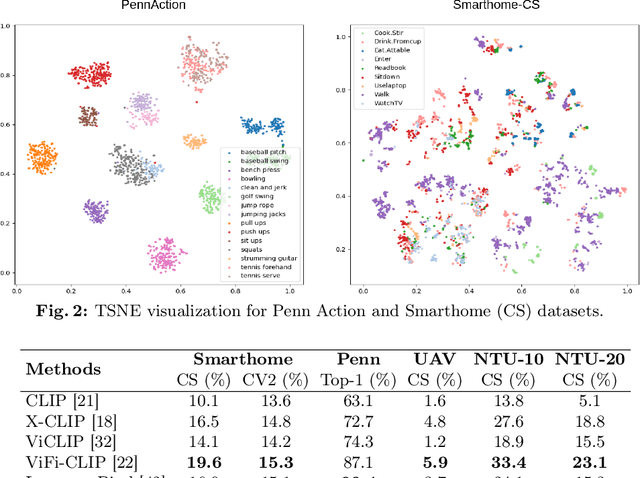
Abstract:Current vision-language foundation models, such as CLIP, have recently shown significant improvement in performance across various downstream tasks. However, whether such foundation models significantly improve more complex fine-grained action recognition tasks is still an open question. To answer this question and better find out the future research direction on human behavior analysis in-the-wild, this paper provides a large-scale study and insight on current state-of-the-art vision foundation models by comparing their transfer ability onto zero-shot and frame-wise action recognition tasks. Extensive experiments are conducted on recent fine-grained, human-centric action recognition datasets (e.g., Toyota Smarthome, Penn Action, UAV-Human, TSU, Charades) including action classification and segmentation.
RoVRM: A Robust Visual Reward Model Optimized via Auxiliary Textual Preference Data
Aug 22, 2024



Abstract:Large vision-language models (LVLMs) often fail to align with human preferences, leading to issues like generating misleading content without proper visual context (also known as hallucination). A promising solution to this problem is using human-preference alignment techniques, such as best-of-n sampling and reinforcement learning. However, these techniques face the difficulty arising from the scarcity of visual preference data, which is required to train a visual reward model (VRM). In this work, we continue the line of research. We present a Robust Visual Reward Model (RoVRM) which improves human-preference alignment for LVLMs. RoVRM leverages auxiliary textual preference data through a three-phase progressive training and optimal transport-based preference data selection to effectively mitigate the scarcity of visual preference data. We experiment with RoVRM on the commonly used vision-language tasks based on the LLaVA-1.5-7B and -13B models. Experimental results demonstrate that RoVRM consistently outperforms traditional VRMs. Furthermore, our three-phase progressive training and preference data selection approaches can yield consistent performance gains over ranking-based alignment techniques, such as direct preference optimization.
Text Modality Oriented Image Feature Extraction for Detecting Diffusion-based DeepFake
May 28, 2024Abstract:The widespread use of diffusion methods enables the creation of highly realistic images on demand, thereby posing significant risks to the integrity and safety of online information and highlighting the necessity of DeepFake detection. Our analysis of features extracted by traditional image encoders reveals that both low-level and high-level features offer distinct advantages in identifying DeepFake images produced by various diffusion methods. Inspired by this finding, we aim to develop an effective representation that captures both low-level and high-level features to detect diffusion-based DeepFakes. To address the problem, we propose a text modality-oriented feature extraction method, termed TOFE. Specifically, for a given target image, the representation we discovered is a corresponding text embedding that can guide the generation of the target image with a specific text-to-image model. Experiments conducted across ten diffusion types demonstrate the efficacy of our proposed method.
CPsyCoun: A Report-based Multi-turn Dialogue Reconstruction and Evaluation Framework for Chinese Psychological Counseling
May 26, 2024
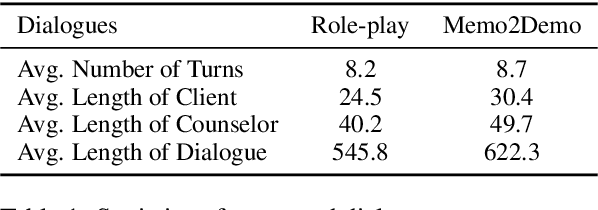

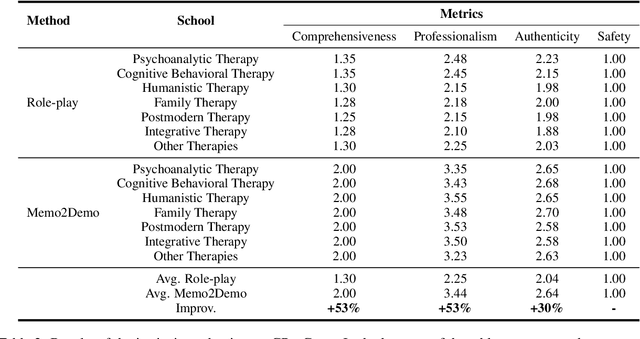
Abstract:Using large language models (LLMs) to assist psychological counseling is a significant but challenging task at present. Attempts have been made on improving empathetic conversations or acting as effective assistants in the treatment with LLMs. However, the existing datasets lack consulting knowledge, resulting in LLMs lacking professional consulting competence. Moreover, how to automatically evaluate multi-turn dialogues within the counseling process remains an understudied area. To bridge the gap, we propose CPsyCoun, a report-based multi-turn dialogue reconstruction and evaluation framework for Chinese psychological counseling. To fully exploit psychological counseling reports, a two-phase approach is devised to construct high-quality dialogues while a comprehensive evaluation benchmark is developed for the effective automatic evaluation of multi-turn psychological consultations. Competitive experimental results demonstrate the effectiveness of our proposed framework in psychological counseling. We open-source the datasets and model for future research at https://github.com/CAS-SIAT-XinHai/CPsyCoun
CPsyExam: A Chinese Benchmark for Evaluating Psychology using Examinations
May 16, 2024



Abstract:In this paper, we introduce a novel psychological benchmark, CPsyExam, constructed from questions sourced from Chinese language examinations. CPsyExam is designed to prioritize psychological knowledge and case analysis separately, recognizing the significance of applying psychological knowledge to real-world scenarios. From the pool of 22k questions, we utilize 4k to create the benchmark that offers balanced coverage of subjects and incorporates a diverse range of case analysis techniques.Furthermore, we evaluate a range of existing large language models~(LLMs), spanning from open-sourced to API-based models. Our experiments and analysis demonstrate that CPsyExam serves as an effective benchmark for enhancing the understanding of psychology within LLMs and enables the comparison of LLMs across various granularities.
 Add to Chrome
Add to Chrome Add to Firefox
Add to Firefox Add to Edge
Add to Edge